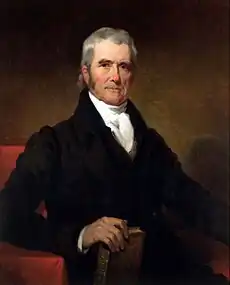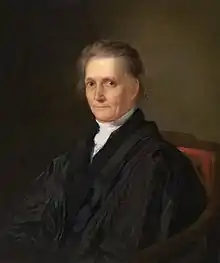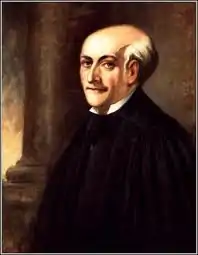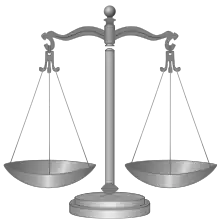| Supreme Court of the United States | |
|---|---|
 | |
| 38°53′26″N 77°00′16″W / 38.89056°N 77.00444°W | |
| Established | March 4, 1789 |
| Location | Washington, D.C. |
| Coordinates | 38°53′26″N 77°00′16″W / 38.89056°N 77.00444°W |
| Composition method | Presidential nomination with Senate confirmation |
| Authorized by | Constitution of the United States, Art. III, § 1 |
| Judge term length | life tenure, subject to impeachment and removal |
| Number of positions | 9 (by statute) |
| Website | supremecourt |
| This article is part of a series on the |
| Supreme Court of the United States |
|---|
 |
| The Court |
| Current membership |
|
| Lists of justices |
|
| Court functionaries |
|
This is a list of cases reported in volume 18 (5 Wheat.) of United States Reports, decided by the Supreme Court of the United States in 1820.[1]
Nominative reports
In 1874, the U.S. government created the United States Reports, and retroactively numbered older privately published case reports as part of the new series. As a result, cases appearing in volumes 1–90 of U.S. Reports have dual citation forms; one for the volume number of U.S. Reports, and one for the volume number of the reports named for the relevant reporter of decisions (these are called "nominative reports").
Henry Wheaton
Starting with the 14th volume of U.S. Reports, the Reporter of Decisions of the Supreme Court of the United States was Henry Wheaton. Wheaton was Reporter of Decisions from 1816 to 1827, covering volumes 14 through 25 of United States Reports which correspond to volumes 1 through 12 of his Wheaton's Reports. As such, the dual form of citation to, for example, Wallace v. Anderson is 18 U.S. (5 Wheat.) 291 (1820).
Justices of the Supreme Court at the time of 18 U.S. (5 Wheat.)
The Supreme Court is established by Article III, Section 1 of the Constitution of the United States, which says: "The judicial Power of the United States, shall be vested in one supreme Court . . .". The size of the Court is not specified; the Constitution leaves it to Congress to set the number of justices. Under the Judiciary Act of 1789 Congress originally fixed the number of justices at six (one chief justice and five associate justices).[2] Since 1789 Congress has varied the size of the Court from six to seven, nine, ten, and back to nine justices (always including one chief justice).
When the cases in 18 U.S. (5 Wheat.) were decided, the Court comprised these seven justices:
| Portrait | Justice | Office | Home State | Succeeded | Date confirmed by the Senate (Vote) |
Tenure on Supreme Court |
|---|---|---|---|---|---|---|
 |
John Marshall | Chief Justice | Virginia | Oliver Ellsworth | January 27, 1801 (Acclamation) |
February 4, 1801 – July 6, 1835 (Died) |
 |
Bushrod Washington |
Associate Justice | Virginia | James Wilson | December 20, 1798 (Acclamation) |
November 9, 1798 (Recess Appointment) – November 26, 1829 (Died) |
 |
William Johnson |
Associate Justice | South Carolina | Alfred Moore | March 24, 1804 (Acclamation) |
May 7, 1804 – August 4, 1834 (Died) |
 |
Henry Brockholst Livingston |
Associate Justice | New York | William Paterson | December 17, 1806 (Acclamation) |
January 20, 1807 – March 18, 1823 (Died) |
 |
Thomas Todd |
Associate Justice | Kentucky | new seat | March 2, 1807 (Acclamation) |
March 3, 1807 – February 7, 1826 (Died) |
 |
Gabriel Duvall |
Associate Justice | Maryland | Samuel Chase | November 18, 1811 (Acclamation) |
November 23, 1811 – January 12, 1835 (Resigned) |
.jpg.webp) |
Joseph Story |
Associate Justice | Massachusetts | William Cushing | November 18, 1811 (Acclamation) |
February 3, 1812 – September 10, 1845 (Died) |
Notable Case in 18 U.S. (5 Wheat.)

La Amistad
La Amistad 18 U.S. (5 Wheat.) 385 (1820) was a 19th-century two-masted schooner, owned by a Spaniard living in Cuba. It became renowned in July 1839 for a slave revolt by Mende captives. The ship was eventually taken into American custody in New Orleans. Spain requested President Martin Van Buren to return the African captives to Cuba under a treaty. Litigation followed. Because of issues of ownership and jurisdiction, the case gained international attention. The case was decided by the Supreme Court of the United States in favor of the Mende, restoring their freedom. It became a symbol in the United States in the movement to abolish slavery.
Citation style
Under the Judiciary Act of 1789 the federal court structure at the time comprised District Courts, which had general trial jurisdiction; Circuit Courts, which had mixed trial and appellate (from the US District Courts) jurisdiction; and the United States Supreme Court, which had appellate jurisdiction over the federal District and Circuit courts—and for certain issues over state courts. The Supreme Court also had limited original jurisdiction (i.e., in which cases could be filed directly with the Supreme Court without first having been heard by a lower federal or state court). There were one or more federal District Courts and/or Circuit Courts in each state, territory, or other geographical region.
Bluebook citation style is used for case names, citations, and jurisdictions.
- "C.C.D." = United States Circuit Court for the District of . . .
- e.g.,"C.C.D.N.J." = United States Circuit Court for the District of New Jersey
- "D." = United States District Court for the District of . . .
- e.g.,"D. Mass." = United States District Court for the District of Massachusetts
- "E." = Eastern; "M." = Middle; "N." = Northern; "S." = Southern; "W." = Western
- e.g.,"C.C.S.D.N.Y." = United States Circuit Court for the Southern District of New York
- e.g.,"M.D. Ala." = United States District Court for the Middle District of Alabama
- "Ct. Cl." = United States Court of Claims
- The abbreviation of a state's name alone indicates the highest appellate court in that state's judiciary at the time.
- e.g.,"Pa." = Supreme Court of Pennsylvania
- e.g.,"Me." = Supreme Judicial Court of Maine
List of cases in 18 U.S. (5 Wheat.)
NOTE: Some decisions have alternate pagination, indicated by "{ }."
| Case Name | Page & year | Opinion of the Court | Concurring opinion(s) | Dissenting opinion(s) | Lower Court | Disposition |
|---|---|---|---|---|---|---|
| Houston v. Moore | 1 (1820) | Washington | Johnson | Story | Pa. | affirmed |
| United States v. Wiltberger | 76 {35} (1820) | Marshall | none | none | C.C.D. Pa. | certification |
| M'Clung v. Ross | 116 {54} (1820) | Marshall | none | none | C.C.D.E. Tenn. | reversed |
| The Venus | 127 (1820) | Johnson | none | none | C.C.D. Ga. | reversed |
| The London Packet | 132 (1820) | Livingston | none | none | C.C.D. Mass. | reversed |
| United States v. Klintock | 144 (1820) | Marshall | none | none | C.C.D. Va. | certification |
| United States v. Smith | 153 {71} (1820) | Story | none | none | C.C.D. Va. | certification |
| United States v. Furlong | 184 (1820) | Johnson | none | none | multiple | certification |
| Stevenson's Heirs v. Sullivant | 207 (1820) | Washington | none | none | C.C.D. Ohio | affirmed |
| Perkins v. Ramsey | 269 {124} (1820) | Todd | none | none | C.C.D. Ky. | affirmed |
| Mandeville v. Welch | 277 {128} (1820) | Story | none | none | C.C.D.C. | reversed |
| Wallace v. Anderson | 291 {134} (1820) | Marshall | none | none | C.C.D. Ohio | reversed |
| Polk's Lessee v. Wendell | 293 (1820) | Johnson | none | none | C.C.D.W. Tenn. | reversed |
| Marshall v. Beverley | 313 (1820) | Livingston | none | none | C.C.D. Va. | reversed |
| Loughborough v. Blake | 317 {146} (1820) | Marshall | none | none | C.C.D.C. | affirmed |
| Mechanics' Bank v. Bank of Columbia | 326 {150} (1820) | Johnson | none | none | C.C.D.C. | affirmed |
| The Josefa Segunda | 338 {156} (1820) | Livingston | none | none | D. La. | affirmed |
| Blake v. Doherty | 359 {165} (1820) | Marshall | none | Johnson | C.C.D.W. Tenn. | reversed |
| Handly's Lessee v. Anthony | 374 (1820) | Marshall | none | none | C.C.D. Ky. | affirmed |
| La Amistad de Rues | 385 (1820) | Story | none | none | D. La. | reversed |
| Lyle v. Rodgers | 394 {181} (1820) | Marshall | none | none | C.C.D.C. | affirmed |
| United States v. Holmes | 412 {189} (1820) | Washington | none | none | C.C.D. Mass. | certification |
| Owings v. Speed | 420 {192} (1820) | Marshall | none | none | C.C.D. Ky. | affirmed |
| Conn v. Penn | 424 {194} (1820) | Marshall | none | none | C.C.D. Pa. | reversed |
| Campbell v. Pratt | 429 {196} (1820) | Johnson | none | none | not indicated | affirmed |
| The Atalanta | 433 (1820) | per curiam | none | none | C.C.D. Ga. | reversed |
| United States v. Lancaster | 434 {198} (1820) | Marshall | none | none | C.C.D. Pa. | dismissed |
Notes and references
- ↑ Anne Ashmore, DATES OF SUPREME COURT DECISIONS AND ARGUMENTS, Library, Supreme Court of the United States, 26 December 2018.
- ↑ "Supreme Court Research Guide". Georgetown Law Library. Retrieved April 7, 2021.
See also
External links
- Case reports in volume 18 (5 Wheat.) from Court Listener
- Case reports in volume 18 (5 Wheat.) from the Caselaw Access Project of Harvard Law School
- Case reports in volume 18 (5 Wheat.) from Google Scholar
- Case reports in volume 18 (5 Wheat.) from Justia
- Case reports in volume 18 (5 Wheat.) from Open Jurist
- Website of the United States Supreme Court
- United States Courts website about the Supreme Court
- National Archives, Records of the Supreme Court of the United States
- American Bar Association, How Does the Supreme Court Work?
- The Supreme Court Historical Society
